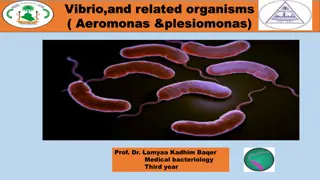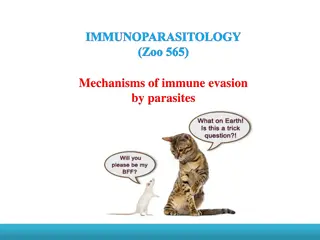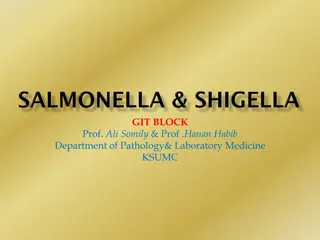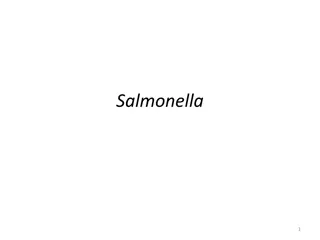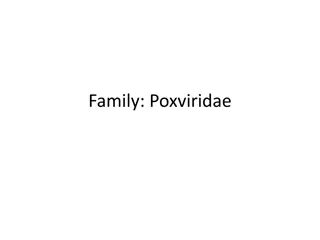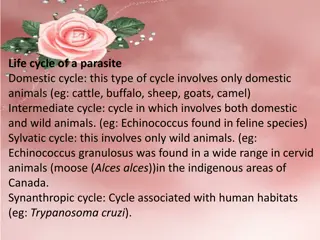Overview of Enterobacteriaceae Family and Their Antigenic Structure
The Enterobacteriaceae family comprises a diverse group of gram-negative rods commonly found in the gut of humans and animals, known for causing various diseases. Key members include Escherichia coli, Shigella, Salmonella, Klebsiella, and more. They are facultative anaerobes, ferment glucose, lack cytochrome oxidase, and convert nitrates to nitrites. Antigenic structures like O antigens and H antigens are crucial for identification purposes. Additionally, the presence of K antigens, colicins (bacteriocins), and virulence factors contribute to the pathogenicity of these bacteria.
Download Presentation

Please find below an Image/Link to download the presentation.
The content on the website is provided AS IS for your information and personal use only. It may not be sold, licensed, or shared on other websites without obtaining consent from the author.If you encounter any issues during the download, it is possible that the publisher has removed the file from their server.
You are allowed to download the files provided on this website for personal or commercial use, subject to the condition that they are used lawfully. All files are the property of their respective owners.
The content on the website is provided AS IS for your information and personal use only. It may not be sold, licensed, or shared on other websites without obtaining consent from the author.
E N D
Presentation Transcript
Enterobacteriaceae Dr. Thanaa Rasheed
The Enterobacteriaceae is a large family of gram-negative rods found primarily in the intestinal tract of humans and animals. They cause a variety of diseases. This family includes: Escherichia coli, Shigella, Salmonella, Klebsiella, Enterobacter, Serratia ,Proteus , Yersinia and others in which some of them are normal flora such as E. coli (coliform).
General properties 1.They are all facultative anaerobes. (2) They ferment glucose None have all (3) cytochrome oxidase (i.e., they are oxidase- negative) and (4) they reduce nitrates to nitrites as part of their energy-generating processes.
Antigenic structure and Virulence factors Antigenic structure used for identification purposes both in the clinical laboratory and in epidemiologic investigations. O antigens The cell wall antigen (also known as the somatic Ags) is the outer polysaccharide portion of the cell wall lipopolysaccharide. Is the basis for the serologic typing of many enteric rods. O antigens are resistant to heat and alcohol and usually are detected by agglutination test. Antibodies to O antigens are predominantly IgM.
Antigenic structure H antigen Is on the flagellar protein(flagellae) . Only on flagellated organisms, such as Escherichia and Salmonella. The H antigens denaturized or removed by heat and alcohol. HAgs agglutinate with anti-HAgAntibodies (IgG).
Antigenic structure K antigen The capsular or K polysaccharide antigens some but not all Enterobacteriaceae such as Klebsiella . are external to O Ag on Some KAg are polysaccharides and others are proteins. The K antigen is identified by the quellung (capsular swelling) reaction in the presence of specific antisera . In Sal. typhi, the cause of typhoid fever, it is called the Vi (or virulence) antigen. ThisAg may interfere with agglutination by O-Antisera. K Ags of E coli cause attachment of the bacteria to the epithelial prior to GIT or UT invasions. cell
Colicins (Bacteriocins) Many gram-negative organisms produce bacteriocins. These high-molecular-weight bactericidal proteins are produced by certain strains of bacteria active against some other strains of the same or closely related species. Their production is controlled by plasmids. e.g: Colicins are produced by E coli; marcescens by Serratia, and pyocins by Pseudomonas. Bacteriocin-producing strains are resistant to their own bacteriocin; thus, bacteriocins can be used for "typing" of organisms.
Toxins Most gram-negative bacteria possess complex lipopolysaccharides in their cell walls (endotoxins). These substances; cell envelope (cytoplasmic membrane, peptidoglycan, outer membrane) endotoxins, have a variety of pathophysiologic effects. Many gram-negative enteric bacteria also produce exotoxins of clinical importance.
Classification Genus and species designations are based on phenotypic characteristics, such as Patterns of carbohydrate fermentation and amino acid breakdown. The O, K, and H antigens are used to further divide some species into multiple serotypes. These types are expressed with letter and number of the specific antigen, such as Escherichia coli O157:H7.
Diseases Caused by Enterobacteriaceae other than Salmonella & Shigella 1. E coli, Proteus, Enterobacter, Klebsiella, Morganella, Providencia, Citrobacter, and Serratia spp all are normal flora of the upper respiratory and genetal tracts. 2. The bacteria become pathogenic only when they reach tissues outside of their normal sites (urinary tract, biliary tract, and other sites in the abdominal cavity). 3. Some of the enteric bacteria (eg, Serratia marcescens, Enterobacter aerogenes) are opportunistic pathogens. 4. When normal host defenses are inadequate particularly in infancy or old age, in the terminal stages of other diseases, after immunosuppression, or with indwelling venous or urethral catheters localized clinically important infections can result, and the bacteria may reach the bloodstream and cause sepsis.
Escherichia coli (E coli) Antigenic structure of Escherichia coli 1. The O, H and K antigen (is the polysaccharide capsule present in some strains). 2. Pili: Most E coli have type 1 (common) hair-like pili extending from the surface. Pili play a role in virulence as mediators of attachment to specific receptor on human epithelial surfaces. 3. Toxins: Exotoxin , -hemolysin ,cytotoxic necrotizing factor (CNF) ,Shiga like toxin (Stx), Labile toxin (LT), Stable toxin (ST)
Pathogenesis & Clinical Findings E. coli Urinary tract infection E coli is the most common cause and accounts for approximately 90% of first urinary tract infections in young women Symptoms 1. Urinary frequency, dysuria, hematuria, and pyuria. 2. Flank pain is associated with upper tract infection. 3. Bacteremia with clinical signs of sepsis. 4. Nephropathogenic E.coli typically produce hemolysin, which is cytotoxic and facilitates tissue invasion.
B. E. coli-associated diarrheal diseases E coli that cause diarrhea are common worldwide. E coli are classified by the characteristics of their virulent properties as: Enteropathogenic E coli (EPEC): Is an important cause of diarrhea in infants, especially in developing countries. Previously was associated with outbreaks of diarrhea in nurseries in developed countries. Pathogenesis 1) EPEC adhere to the mucosal cells of the small bowel. 2) Chromosomally mediated factors promote tight adherence. 3) There is loss of microvilli (effacement) 4) Formation of filamentous actin pedestals or cup-like structures, and, occasionally, entry of the EPEC into the mucosal cells. 5) The result of EPEC infection is watery diarrhea, which is usually self-limited but can be chronic cured by antibiotic treatment.
Enterotoxigenic E coli (ETEC): Is a common cause of "traveler's diarrhea" and a very important cause of diarrhea in infants in developing countries. Pathogenesis 1. ETEC colonization factors specific for humans promote adherence of bacteria to epithelial cells of the small bowel. 2. Some strains of ETEC produce a heat-labile exotoxin (LT).It is under the genetic control of a plasmid. Its subunit B attaches to the ganglioside at the brush border of epithelial cells of the small intestine and facilitates the entry of subunit A into the cell, where the latter activates adenylyl cyclase. This markedly increases the local concentration of cyclic adenosine monophosphate (cAMP), which results in intense and prolonged hypersecretion of water and chlorides and inhibits the reabsorption of sodium. The gut lumen is distended with fluid, and hypermotility and diarrhea ensue, lasting for several days. 3. Some strains of ETEC produce the heat-stable enterotoxin STawhich is under the genetic control of a heterogeneous group of plasmids. STaactivates guanylyl cyclase in enteric epithelial cells and stimulates fluid secretion. 4. Many STa-positive strains also produce LT. The strains with both toxins produce a more severe diarrhea.
Enterohemorrhagic E coli (EHEC): Also known as Shiga toxin producing E coli (STEC), Produce cytotoxic toxins (verotoxins). There are at least two antigenic forms of the toxin referred to as Shiga-like toxin 1 and Shiga-like toxin 2. E coli O157:H7 is the most common serotype and is the one that can be identified in clinical specimens. Symptoms 1. E coli hemorrhagic colitis, a severe form of diarrhea. 2. Hemolytic uremic syndrome, a disease resulting in acute renal failure Microangiopathic hemolytic anemia and thrombocytopenia. Control Can be prevented by thoroughly cooking ground beef.
Enteroinvasive E coli (EIEC): 1) Produces a disease very similar to shigellosis. 2) The disease occurs most commonly in children in developing countries and in travelers to these countries. Like Shigella, EIEC strains are non-lactose or late lactose fermenters and are nonmotile. 3) 4) EIEC produce disease by invading intestinal mucosal epithelial cells. Enteroaggregative E coli (EAEC): 1) Causes acute and chronic diarrhea in persons in developing countries. 2) Also cause food-borne illnesses in industrialized countries. 3) They are characterized by their specific patterns of adherence to human cells. 4) EAEC produce ST-like toxin and a hemolysin.
C. Sepsis When normal host defenses are inadequate, E coli may reach the bloodstream and cause sepsis. 1) Newborns may be highly susceptible to E coli sepsis because they lack IgM antibodies. 2) 3) Sepsis may occur secondary to urinary tract infection. D. Meningitis 1) E coli is the leading causes of meningitis in infants. Approximately 75% of E coli from meningitis cases have the K1 antigen. 2)
Klebsiella, Enterobacter, Serratia, Proteus, Morganella, Providencia; & Citrobacter Klebsiella 1) K pneumoniae is present in the respiratory tract and feces of about 5% of normal individuals. 2) It causes a small proportion (about 1%) of bacterial pneumonias. K pneumoniae can produce extensive hemorrhagic necrotizing consolidation of 3) the lung. 4) It produces urinary tract infection and bacteremia with focal lesions in debilitated patients. 5) Klebsiella sp. rank among the top ten bacterial pathogens responsible for hospital-acquired infections. 6) Klebsiella ozaenae is the other klebsiellae are associated with inflammatory conditions of the upper respiratory tract has been isolated from the nasal mucosa. .
Enterobacter Three species of Enterobacter, E cloacae, E aerogenes, and E sakazakii . 1) 2) These bacteria ferment lactose, it has small capsules that produce mucoid colonies and they are motile. 3) These organisms cause a broad range of hospital acquired infections such as pneumonia, urinary tract infections, wound and device infections. Serratia 1) S marcescens is a common opportunistic pathogen in hospitalized patients. 2) Serratia endocarditis especially in narcotics addicts and hospitalized patients. (usually nonpigmented) causes pneumonia, bacteremia and
Enterobacter Serratia
Proteus 1) Proteus species produce infections in humans only when the bacteria leave the intestinal tract. 2) They are found in urinary tract infections and produce bacteremia, pneumonia, and focal lesions in debilitated patients or those receiving intravenous infusions. 3) P mirabilis causes urinary tract infections and occasionally other infections. 4) Proteus vulgaris and Morganella morganii are important nosocomial pathogens. 5) Proteus species produce urease, resulting in rapid hydrolysis of urea with liberation of ammonia. Thus, in urinary tract infections with Proteus, the urine becomes alkaline, promoting stone formation. The rapid motility of Proteus may contribute to its invasion of the urinary tract. 6)
Acinetobacter baumannii 1) Is an opportunistic human pathogen. 2) Part of the normal microflora of between 25-70% of the population . 3) Infections appear to be concentrated in intensive care units (ICUs), burns wards, high dependency units (HDUs) and other areas where very sick patients reside. 4) There has also been a trend of military personnel in Iraq and Afghanistan acquiring A. baumannii infections upon repatriation. 5) It is thought that A. baumannii can also be spread by airborne transmission, person-to-person contact, through contaminated environmental surfaces and medical equipment.
Providencia 1) Providencia species (Providencia rettgeri, Providencia alcalifaciens, and Providencia stuartii) are members of the normal intestinal flora. 2) All cause urinary tract infections and occasionally other infections and are often resistant to antimicrobial therapy. Citrobacter Cause urinary tract infections and sepsis.
Diagnostic Laboratory Tests Specimens: Specimens include urine, blood, pus, spinal fluid, sputum, or other material, as indicated by the localization of the disease process. Smears :For Gram stain. The Enterobacteriaceae resemble each other morphologically. The presence of large capsules is suggestive of Klebsiella. Culture :Specimens are plated on enrichment ,blood agar and differential media. Biochemical tests : Very important. Serotyping.
Treatment The sulfonamides, ampicillin, cephalosporins, fluoroquinolones, and aminoglycosides have marked antibacterial effects against the enteric bacteria with variation in the susceptibility so the laboratory tests for antibiotic susceptibility are essential. Multiple drug resistance is common and is under the control of transmissible plasmids. Certain conditions predisposing to infection by these organisms require surgical correction, obstruction, closure of a perforation in an abdominal organ, or resection of a bronchiectatic portion of lung. Treatment of gram-negative bacteremia and impending septic shock requires rapid institution of antimicrobial therapy, restoration of fluid and electrolyte balance, and treatment of disseminated intravascular coagulation. eg, relief of urinary tract
The Shigellae The natural habitat of shigellae is the intestinal tracts of humans and other primates, where they produce bacillary dysentery. Shigellae are transmitted by "food, fingers, feces, and flies" from person to person. Most cases of Shigella infection occur in children under 10 years of age. There are four Groups and Types of shigellae: Shigella dysenteriae Group A Shigella flexneri Group B Shigella boydii Group C Shigella sonnei Group D
General properties 1) Shigellae are slender gram-negative rods; coccobacillary forms occur in young cultures. Shigellae are facultative anaerobes but grow best 2) Culture: aerobically. Convex, circular, transparent colonies with intact edges reach a diameter of about 2 mm in 24 hours. Growth Characteristics: All shigellae ferment glucose. With the exception of Shigella sonnei, they do not ferment lactose on differential media. 3) Shigellae form acid from carbohydrates but rarely produce gas. They may also be divided into those that ferment mannitol and those that do not. 4)
Pathogenesis & Pathology 1) Shigella infections are almost always limited to the gastrointestinal tract; bloodstream invasion is quite rare. 2) Shigellae are highly communicable; the infective dose is on the order of 102 organisms 3) The essential pathologic process is invasion of the mucosal epithelial cells (eg, M cells) by induced phagocytosis, escape from the phagocytic vacuole, multiplication and spread within the epithelial cell cytoplasm, and passage to adjacent cells. 4) Microabscesses in the wall of the large intestine and terminal ileum lead to necrosis of the mucous membrane, superficial ulceration, bleeding, and formation of a "pseudomembrane" on the ulcerated area. 5) Pseudomembrane consists of fibrin, leukocytes, cell debris, a necrotic mucous membrane, and bacteria. 6) As the process subsides, granulation tissue fills the ulcers and scar tissue forms.
Toxins Endotoxin: a) Upon autolysis, all shigellae release their toxic lipopolysaccharide. b) This endotoxin probably contributes to the irritation of the bowel wall. Shigella dysenteriae Exotoxin : a) S dysenteriae type 1 (Shiga bacillus) produces a heat-labile exotoxin that affects both the gut and the central nervous system. b) The exotoxin is a protein that is antigenic (stimulating production of antitoxin) and lethal for experimental animals. c) Acting as an enterotoxin, it produces diarrhea as does the E coli Shiga-like toxin. d) It inhibits sugar and amino acid absorption in the small intestine. e) Acting as a "neurotoxin," this material may contribute to the extreme severity and fatal nature of S dysenteriae infections and to the central nervous system reactions observed in them (ie, meningismus, coma).
Clinical Findings 1) After a short incubation period (1 2 days), there is a sudden onset of abdominal pain, fever, and watery diarrhea. 2) A day or so later, as the infection involves the ileum and colon, the number of stools increases; they are less liquid but often contain mucus and blood. 3) Each bowel movement is accompanied by straining and tenesmus (rectal spasms), with resulting lower abdominal pain. 4) Fever and diarrhea subside spontaneously in 2 5 days. 5) In children and the elderly, loss of water and electrolytes may lead to dehydration, acidosis, and even death. The illness due to S dysenteriae may be particularly severe. 6) 7) On recovery, most persons shed dysentery bacilli for only a short period, but a few remain chronic intestinal carriers.
Diagnosis Specimens: include fresh stool, mucus flecks, and rectal swabs for culture. Large numbers of fecal leukocytes and some red blood cells often are seen microscopically. Serum specimens, if desired, must be taken 10 days apart to demonstrate a rise in titer of agglutinating antibodies. Culture: The materials are streaked on differential media (eg, MacConkey or EMB agar) and on selective media (Hektoen enteric agar or Salmonella-Shigella agar and XLD), which suppress other Enterobacteriaceae and gram-positive organisms. Colorless (lactose-negative) colonies are inoculated into triple sugar iron agar. Organisms that fail to produce H2S, that produce acid but not gas in the butt and an alkaline slant in triple sugar iron agar medium, and that are nonmotile should be subjected to slide agglutination by specific Shigella antisera. Serology: Serology is not used to diagnose Shigella infections.
Treatment Ciprofloxacin, ampicillin, doxycycline, and trimethoprim- sulfamethoxazole can suppress acute clinical attacks of dysentery and shorten the duration of symptoms. Multiple drug resistance can be transmitted by plasmids, and resistant infections are widespread. Many cases are self- limited. Control Sanitary control of water, food, and milk; sewage disposal; and fly control; (2) isolation of patients and disinfection of excreta; (3) detection of subclinical cases and carriers, particularly food handlers; and (4) antibiotic treatment of infected individuals.
The Salmonella o Salmonellae are often pathogenic for humans or animals when acquired by the oral route. o They are transmitted from animals and animal products to humans, where they cause enterocolitis, enteric fevers such as typhoid fever, and septicemia with metastatic infections such as osteomyelitis. o The typhoidal species are Sal. typhi and Sal. Paratyphi A, B. The nontyphoidal species are the many strains of Sal. enteritidis. Sal. choleraesuis is the species most often involved in metastatic infections.
General properties 1. Salmonellae vary in length. Most isolates are motile with peritrichous flagella. Salmonellae grow readily on simple media, but they almost never ferment lactose or sucrose. They form acid and sometimes gas from glucose and mannose. They usually produce H2S. They survive freezing in water for long periods. Salmonellae are resistant to certain chemicals (eg, brilliant green, sodium tetrathionate, sodium deoxycholate) that inhibit other enteric bacteria; such compounds are therefore useful for inclusion in media to isolate salmonellae from feces.
Epidemiology Salmonella Typhi, Salmonella Choleraesuis, and perhaps Salmonella Paratyphi A and Salmonella Paratyphi B are primarily infective for humans and from a human source (carriers). The reservoir for human infection are poultry, pigs, rodents, cattle, pets (from turtles to parrots), and many others. The organisms almost always enter via the oral route, usually with contaminated food or drink. The mean infective dose to produce clinical or subclinical infection in humans is 105 108salmonellae (but perhaps as few as 103Salmonella Typhi organisms). Among the host factors that contribute to resistance to salmonella infection are gastric acidity, normal intestinal microbial flora, and local intestinal immunity.
Clinical Findings & Pathogenesis Salmonellae produce three main types of disease in humans, but mixed forms are frequent: A. Enteric Fevers (Typhoid fever) Salmonella Typhi (typhoid fever) is the most important. The ingested salmonellae reach the small intestine, from which they enter the lymphatics and then the bloodstream. They are carried by the blood to many organs, including the intestine. The organisms multiply in intestinal lymphoid tissue and are excreted in stools. After an incubation period of 10 14 days, fever, malaise, headache, constipation, bradycardia, and myalgia occur.
The fever rises to a high plateau, and the spleen and liver become enlarged. Rose spots, usually on the skin of the abdomen or chest, are seen briefly in rare cases. The white blood cell count is normal or low. In the preantibiotic era, the chief complications of enteric fever were intestinal hemorrhage and perforation, The mortality rate was 10 15%. Treatment with antibiotics has reduced the mortality rate to less than 1%. The principal lesions are hyperplasia and necrosis of lymphoid tissue (eg, Peyer's patches), hepatitis, focal necrosis of the liver, and inflammation of the gallbladder, periosteum, lungs, and other organs.
B. Bacteremia with Focal Lesions This is associated commonly with S choleraesuis but may be caused by any salmonella serotype. Following oral infection, there is early invasion of the bloodstream (with possible focal lesions in lungs, bones, manifestations are often absent. meninges, etc), but intestinal C. Enterocolitis (Formely gastroenteritis) This is the most common manifestation of salmonella infection. 1. Salmonella Typhimurium and Salmonella Enteritidis are prominent, but enterocolitis can be caused by any serotypes of salmonellae. 2. Eight to 48 hours after ingestion of salmonellae, there is nausea, headache, vomiting, and profuse diarrhea, with few leukocytes in the stools. 3. Low-grade fever is common, but the episode usually resolves in 2 3 days. 4. Inflammatory lesions of the small and large intestine are present. 5. Bacteremia is rare (2 4%) except in immunodeficient persons. 6.
Diagnosis Specimens Blood for culture must be taken repeatedly. In enteric fevers and septicemias, blood cultures are often positive in the first week of the disease. Bone marrow cultures may be useful. Urine cultures may be positive after the 2nd week. Stool specimens also must be taken repeatedly. In enteric fevers, the stools yield positive results from the 2nd or 3rd week and in enterocolitis, during the 1st week. A positive culture of duodenal drainage establishes the presence of salmonellae in the biliary tract in carriers.
Bacteriologic Methods for Isolation of Salmonellae a) Enrichment cultures The specimen (usually stool) also is put into selenite F or tetrathionate broth, both of which inhibit replication of normal intestinal flora . After incubation for 1 2 days, this is plated on differential and selective media. b) Differential medium cultures EMB, MacConkey, or deoxycholate medium permits rapid detection of lactose nonfermenters. c) Bismuth sulfite medium permits rapid detection of Salmonella typhi which form black colonies because of H2S production. d) Selective medium cultures The specimen is plated on salmonella- shigella (SS) agar, Hektoen enteric agar, XLD, or deoxycholate-citrate agar.
Biochemical reaction Final identification Suspect colonies from solid media are identified by biochemical reaction patterns Serologic Methods Are used to identify unknown cultures with known sera and may also be used to determine antibody titers in patients with unknown illness and include: a) SlideAgglutination Test 1)Known sera and unknown culture are mixed on a slide. 2) Clumping can be observed within a few minutes (+ve). 3)This test is particularly useful for rapid preliminary identification. 4)There are commercial kits available to agglutinate and serogroup salmonellae by their O antigens:A, B, C1, C2, D, and E.
b) Tube dilution agglutination test (Widal test) Serum agglutinins rise sharply during the second and third weeks of Salmonella Typhi infection. The Widal test to detect these antibodies against the O , Vi and H antigens. At least two serum specimens, obtained at intervals of 7 10 days, are needed to prove a rise in antibody titer. Serial dilutions of unknown sera are tested against antigens from representative salmonellae. False-positive and false-negative results occur. Results Rising titer against the O antigen of >1:320 active infection Rising titer against the H antigen of >1:640 positive. High titer of antibody to the Vi antigen carriers. Rapid colorimetric and enzyme immunoassay methods.
Treatment Enteric fevers and bacteremias with focal lesions require antimicrobial treatment while enterocolitis does not. Antimicrobial therapy of invasive Salmonella infections is with ampicillin, trimethoprim-sulfamethoxazole, or a third-generation cephalosporin. Antimicrobial treatment of Salmonella enteritis in neonates is important. In severe diarrhea, replacement of fluids and electrolytes is essential. Susceptibility testing is an important adjunct to selecting a proper antibiotic. In most carriers, the organisms persist in the gallbladder (particularly if gallstones are present) and in the biliary tract. Some chronic carriers have been cured by ampicillin alone, but in most cases cholecystectomy must be combined with drug treatment.



